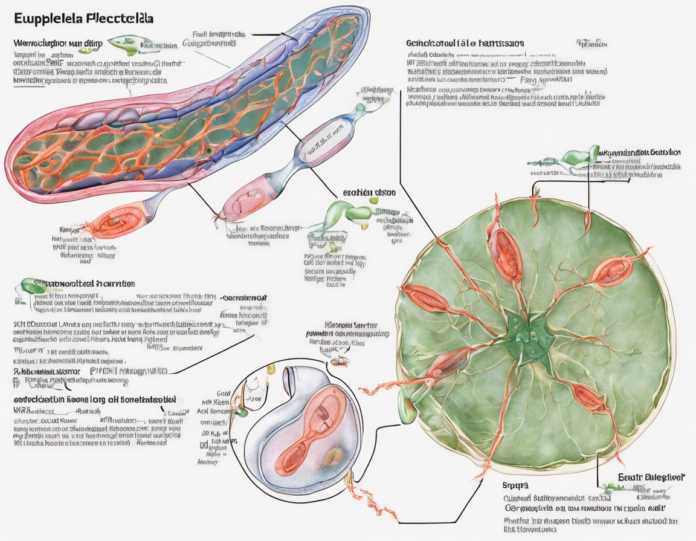Introduction
Euplectella, commonly known as the Venus’ flower basket, is a fascinating deep-sea glass sponge species known for its intricate and delicate skeletal structure. Ranging from the tropical oceans of the Indo-Pacific region to the depths of the ocean floor, Euplectella showcases a remarkable example of nature’s architectural marvels. In this article, we will delve into the intricate Euplectella diagram and uncover the beauty and complexity behind this unique organism.
Understanding Euplectella
Euplectella belongs to the class Hexactinellida, which are glass sponges characterized by their siliceous spicules that form a skeletal framework. Unlike other sponges, Euplectella has a cylindrical body with a lattice-like structure made of fused siliceous spicules. The interlaced network of silica fibers provides structural integrity to the sponge, allowing it to withstand the pressures of the deep-sea environment.
Anatomy of Euplectella
-
Body Structure: The body of Euplectella consists of a hollow elongated tube called a skeleton. This skeleton is made up of intricate siliceous spicules that intersect to form a mesh-like pattern. The mesh structure not only provides support but also allows water flow through the sponge for feeding and respiration.
-
Spicules: The spicules of Euplectella are long, thin, and translucent structures that are composed of silica. These spicules are fused together in a hexagonal pattern, creating a sturdy and flexible framework for the sponge. The spicules are arranged in a crisscross pattern, resembling a delicate lacework that is both beautiful and functional.
-
Skeleton Reinforcement: In addition to the spicules, Euplectella reinforces its skeleton with organic fibers made of spongin, a proteinaceous material. These organic fibers interweave with the siliceous spicules, providing additional strength and elasticity to the sponge’s structure.
Biological Significance
-
Symbiotic Relationships: Euplectella has a symbiotic relationship with a species of shrimp known as Spongicolidae. The shrimp larvae enter the sponge as juveniles and live inside the sponge, feeding on particles and debris trapped in the sponge’s mesh structure. In return, the shrimp provide protection and help clean the sponge, creating a mutually beneficial relationship.
-
Biomedical Applications: The unique structure of Euplectella has inspired researchers to explore its potential applications in biomedical engineering. The sponge’s intricate lattice structure has been studied for use in tissue engineering, drug delivery systems, and biocompatible scaffolds for regenerative medicine.
Conservation and Threats
Despite its remarkable attributes, Euplectella faces threats from deep-sea mining, pollution, and habitat destruction. Conservation efforts are crucial to protect this species and the delicate ecosystems it supports. By raising awareness and implementing sustainable practices, we can ensure the long-term survival of Euplectella and other deep-sea organisms.
Frequently Asked Questions (FAQs)
- What is the significance of Euplectella’s skeletal structure?
-
Euplectella’s skeletal structure provides support and protection to the sponge, allowing it to thrive in the deep-sea environment. The intricate mesh-like pattern also aids in capturing food particles and facilitating water flow.
-
How does Euplectella interact with other organisms?
-
Euplectella forms symbiotic relationships with organisms like the shrimp Spongicolidae, which live inside the sponge and benefit from its shelter and food supply.
-
What are the potential biomedical applications of Euplectella?
-
Researchers have explored using Euplectella’s lattice structure for tissue engineering, drug delivery systems, and regenerative medicine due to its biocompatibility and unique properties.
-
How can we contribute to the conservation of Euplectella?
-
Supporting conservation efforts, promoting sustainable practices, and raising awareness about the importance of deep-sea ecosystems can help protect Euplectella and its habitat.
-
Are there any specific regulations in place for the protection of Euplectella?
- Various international agreements and regional conservation initiatives aim to protect deep-sea habitats, including those where Euplectella resides. Compliance with these regulations is essential for safeguarding marine biodiversity.
In conclusion, the intricate Euplectella diagram serves as a testament to the wonders of nature’s design and the interconnectedness of marine life. By studying and preserving species like Euplectella, we gain insights into the diversity and resilience of organisms in the deep sea, highlighting the importance of conservation and sustainable practices for the future of our planet.

